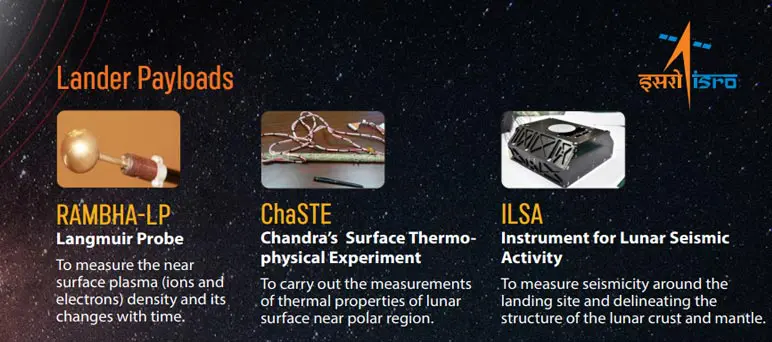Revolutionary Tech Inside Chandrayaan-3’s Vikram Lander: What You Didn’t Know
Chandrayaan-3 was launched on July 14, 2023, and it instantly became the country’s hottest topic. However, the race with the Russian lunar mission Luna-25 has made it an international sensation. All eyes are on both missions to see who lands first on the southern polar region of the moon. As Russia attempts to demonstrate the landing capabilities on Moon, the Indian mission carries a lot more scientific muscle and brain. Let’s have a look at the advanced technologies present in Chandrayaan-3 Lander Vikram to ensure that it lands on the moon at any cost.
Chandrayaan-3 Mission Objectives
Even as the Chandrayaan-3 lander, Vikram, is getting closer and closer to the Moon, most of us are not aware of the objectives of the mission.
As per ISRO, Chandrayaan-3 has 3 mission objectives
- A safe and soft Landing on Lunar Surface
- Roving on the moon (Pragyan rover)
- To conduct on-site scientific experiments.
In order to achieve these mission objectives, the entire mission is equipped with state-of-the-art scientific technologies and instruments. One of the most important steps in the mission is the soft landing on the south-polar region of the moon. The other 2 mission objectives will fail if the first objective isn’t achieved. Hence, keeping in mind the mishap with Chandrayaan 2 lander, ISRO has used advanced technologies to make sure that the landing is perfect.
Advanced technologies present in Chandrayaan-3 Lander Vikram

Various payloads on Vikram Lander. Source: isro.gov.in
We are jubilant about the progress of the Chandrayaan-3 moon mission and hopeful of a smooth landing. However, we are unaware of the immense hard work that has been put in by Indian scientists in making this mission a success.
Altimeters: Laser & RF based Altimeter
An altimeter is a device used to measure the altitude or height of the lander from the surface of the moon. The laser Altimeter, which uses RF pulses, will be used to study the shape of the surface of the moon. This is a critical element for choosing the right landing spot.
Velocimeters: Laser Doppler Velocimeter
The velocimeter is a device that measures the instantaneous velocities of gas and fluid particles. The velocimeter works by detecting the light scattered by small particles suspended in the lunar atmosphere. This method has a very high accuracy (approximately ± 0.2%).
Lander Horizontal Velocity Camera in Chandrayaan-3 Lander

An image of the lunar surface captured by LHVC on Chandrayaan-3. Source: ISRO
The images from the Lander Horizontal Velocity Camera will be used to estimate the horizontal velocity of the Vikram lander during the descent phase. This will be used to update the velocities computed by the Navigation System and control the soft landing.
Inertial Measurement: Laser Gyro based Inertial referencing and Accelerometer package
The Laser Gyro-based Inertial referencing uses gyroscopes, accelerometers, and other electronics to provide accurate attitude, velocity and navigation information to Vikram Lander. Similar technology is also used in the navigation of airplanes. In simple terms, this technology is the eyes and ears of the Chandrayaan-3 Lander to keep it stable and steady during the descent phase.
Propulsion System: 800N Throttleable Liquid Engines, 58N attitude thrusters & Throttleable Engine Control Electronics
The propulsion system will act on the basis of the navigational data and maneuver the trajectory of the Vikram Lander for a safe and soft landing. The attitude of the Lander means its orientation in the space. It determines which side is the lander facing and the angle at which it is descending. The attitude thrusters are very small thrusters pointing in different directions. These thrusters contain gases that are fired in specific directions, based on computed navigational input, to maintain the right attitude or orientation of the Lander.
Navigation, Guidance & Control (NGC): Powered Descent Trajectory Guidance
While the other systems are required for a Safe landing, the NGC and Powered Descent guidance systems are critical for a Soft landing. The Powered Descent Guidance system determines the required direction and magnitude of the engine thrust during the final stage of the descent, that is landing. The controlled thrust from the engines, in the right direction, ensures that the lander slows down close to the surface. Finally, it aids in a soft landing while maintaining the right orientation.
Hazard Detection and Avoidance: Lander Hazard Detection & Avoidance Camera and Processing Algorithm
The hazard detection algorithms take in maps of the features of the lunar surface to detect landing spots. This detection is based on surface roughness and angle, or the size of the object. The hazard avoidance program chooses safe landing sites by maximizing the Lander’s distance to the nearest hazard. It may sound very simple, however, programmatically reading the images captured by the avoidance camera and processing them for navigational output, in real-time, is a very complex program.
Landing Leg Mechanism in Chandrayaan-3 Lander
The Landing Leg is a part used to prevent rockets from landing on their engines and other parts, as they will break on impact if the Lander’s velocity exceeds 5.5 m/s. Landing legs are stowed in the Lander body, until deployment. During the descent, the latches unlock and release the legs. The tip of each leg is pushed away from the lander’s body. Upon touchdown, leg attenuation mechanisms protect the lander body by dissipating the impact. This is the final step in landing and a crucial one for Soft landing.
These advanced technologies present in Chandrayaan-3 are a matter of pride for every Indian. Even more so because of technological marvels that we developed with budgetary constraints. The total cost of Chandrayaan-3 is less than Rs. 615 Crores, which is less than half the budget of the Hollywood movie Interstellar. We wish all the luck to ISRO in achieving all 3 mission objectives successfully! To read more such posts, check out our Technology section.




